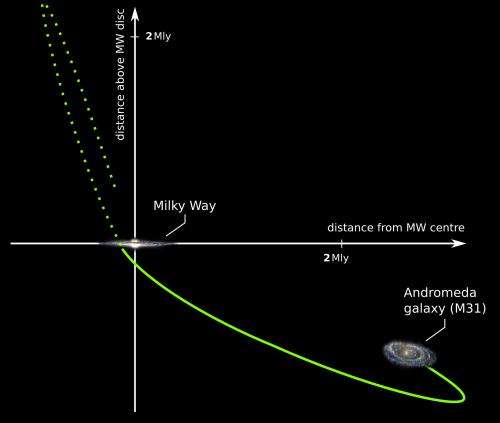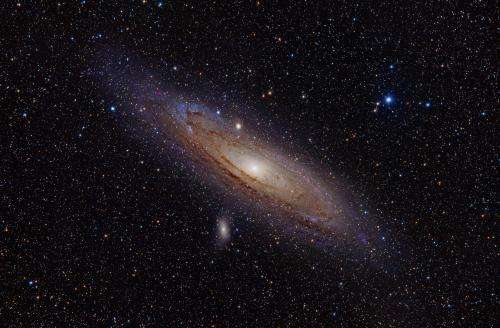Did Andromeda crash into the Milky Way 10 billion years ago?

(Phys.org) —For many years scientists have believed that our Galaxy, the Milky Way, is set to crash into its larger neighbour, the Andromeda Galaxy, in about 3 billion years' time and that this will be the first time such a collision has taken place. But now a European team of astronomers led by Hongsheng Zhao of the University of St Andrews propose a very different idea; that the two star systems collided once before, some 10 billion years ago and that our understanding of gravity is fundamentally wrong. Remarkably, this would neatly explain the observed structure of the two galaxies and their satellites, something that has been difficult to account for until now. Dr Zhao will present the new work at the RAS National Astronomy Meeting in St Andrews on Thursday 4 July.
The Milky Way, made up of about 200 billion stars, is part of a group of galaxies called the Local Group. Astrophysicists often theorise that most of the mass of the Local Group is invisible, made of so-called dark matter. Most cosmologists believe that across the whole universe, this matter outweighs 'normal' matter by a factor of five. The dark matter in both Andromeda and the Milky Way then makes the gravitational pull between the two galaxies strong enough to overcome the expansion of the cosmos, so that they are now moving towards each other at around 100 km per second, heading for a collision 3 billion years in the future.
But this model is based on the conventional model of gravity devised by Newton and modified by Einstein a century ago, and it struggles to explain some properties of the galaxies we see around us. Dr Zhao and his team argue that at present the only way to successfully predict the total gravitational pull of any galaxy or small galaxy group, before measuring the motion of stars and gas in it, is to make use of a model first proposed by Prof. Mordehai Milgrom of the Weizmann Institute in Israel in 1983.
This modified gravity theory (Modified Newtonian Dynamics or MOND) describes how gravity behaves differently on the largest scales, diverging from the predictions made by Newton and Einstein.
Dr Zhao (University of St Andrews) and his colleagues have for the first time used this theory to calculate the motion of Local Group galaxies. Their work suggests that the Milky Way and Andromeda galaxies had a close encounter about 10 billion years ago. If gravity conforms to the conventional model on the largest scales then taking into account the supposed additional pull of dark matter, the two galaxies would have merged.

"Dark matter would work like honey: in a close encounter, the Milky Way and Andromeda would get stuck together, figuratively speaking", says team member Prof. Pavel Kroupa from Bonn University. "But if Milgrom's theory is right", says his colleague Dr Benoit Famaey (Observatoire Astronomique de Strasbourg), "then there are no dark particles and the two large galaxies could have simply passed each other thereby drawing matter from each other into long thin tidal arms."
New little galaxies would then form in these arms, "a process often observed in the present-day universe", adds team member Fabian Lueghausen, also from Bonn. Dr Zhao explains: "The only way to explain how the two galaxies could come close to each other without merging is if dark matter isn't there. Observational evidence for a past close encounter would then strongly support the Milgromian theory of gravity."
Just such a signature might already have been found. Astronomers struggle to account for the distribution of dwarf galaxies in orbit around both the Milky Way and Andromeda. The dwarf galaxies could be explained if they were born from gas and stars ripped out of the two parent galaxies during their close encounter.
Pavel Kroupa sees this as the 'smoking gun' for the collision. "Given the arrangement and motion of the dwarf galaxies, I can't see how any other explanation works", he comments.
The team now plan to model the encounter using Milgromian dynamics and are developing a computer code at Bonn University for this purpose.
In the new model, the Milky Way and Andromeda are still going to crash into each other again in the next few billion years, but it will feel like 'deja vu'. And the team believes that their discovery has profound consequences for our current understanding of the Universe. Pavel Kroupa concludes, "If we are right, the history of the cosmos will have to be rewritten from scratch."
More information: A preprint of the the paper, entitled "Local Group timing in Milgromian dynamics. A past Milky Way-Andromeda encounter at z>0.8", is available from arxiv.org/abs/1306.6628
Provided by Royal Astronomical Society



















